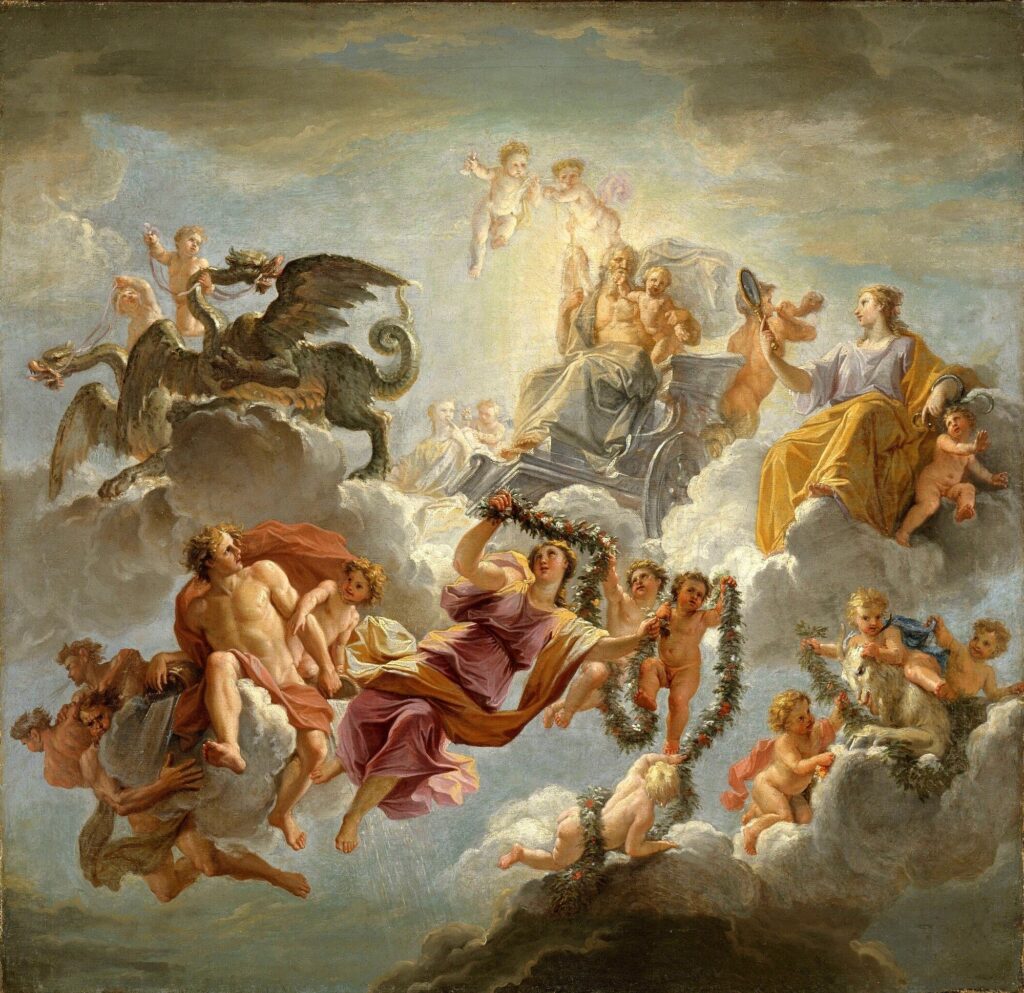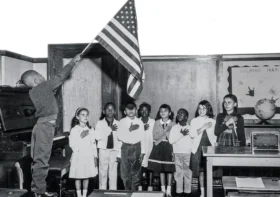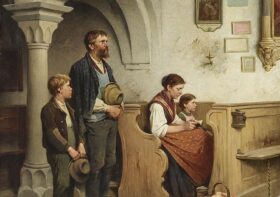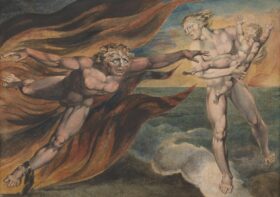The Wheel of Time

The Triumph of Saturn on his Chariot Pulled by Dragons (1671) by Noël Coypel I
The modern man finds himself in a very queer position. He desires to deny primitive religion, to shed the superstitious skin in which the human race incubated for so very long. He desires to do this, however, whilst retaining such titles as “mystic” or “spiritually-minded”. For example, the core of Hinduism, he tells us, is the idea of a guiding, Karmic force or an underlying unity common to all creatures, and the fat that he has trimmed off is comprised of so many gods and goddesses, reincarnation, the generation of all creation from a sacred sound, etc.
In this way, he thinks he can have his scientific cake, glaze it with a vague though palatable spirituality, and eat it too. This is the essence of New Age thought, and it is terribly useful. He can be enlightened in the lab and enlightened in the yoga studio all in the course of a single evening.
But, when pressed, the modern man has no real theology. He squirms when asked such concrete questions as “What makes man special?” or “How did the universe come to exist?” or “Who is responsible for miracles?” Any religion, Hinduism included, has no problem answering these questions, so why can’t the modern man?
He struggles under this load precisely because what he thinks he is shedding is, in fact, what he is retaining, and what he is retaining is that which he believes to be shedding. That is, the core of Hinduism contains such doctrines as polytheism, reincarnation, and the creation myth, not the trite spirituality that issues therefrom. The middle ground in which the modern man feels so at home is actually a no-man’s land as foreign to the Hindu as to the Christian.
The Chirstian, however, has a viable point of egress, an escape rope, which is always available to the modern man, namely Christ. Insofar as all religions are pursuing truth, goodness, and beauty, they are pursuing Christ. It follows then that the religious roads departing from Christ can be just as easily traveled back to Him.
Christ, Lord of all Creation, is large enough to swallow the innumerable deities of Hinduism. Brahma creates? Very well, all things were created through Christ and for Christ (Colossians 1:16). Shiva destroys? Marvelous. Christ has conquered death itself. The equation does not work in the reverse. Ganesha is the god of beginnings, but what is he to do with the timeless God-man? Krishna is the god of love, but how is he to accommodate the God who is Love?
This can be seen perhaps no more clearly than in the Hindu concept of time. The wheel of time is one of modern man’s favorite Hindu toys and for good reason. Is there anything more poetic? And who can deny that history repeats itself? But the analogy crumbles in the both the Hindu and the modern man’s hands.
What the Hindu has is a wheel without destination. Time runs on and on until everything and everyone is consumed into Brahman in a sort of metaphysical stasis. Likewise, for the modern man, time runs on and on until the heat death of the universe. In both worldviews, the wheel of time slows to a halt before ceasing to exist altogether.
Contrast this with Christianity which treats the great wheel of time much more concretely. Like any wheel, only the lowest part of it makes contact with the ground (the material universe) as it turns. This touchpoint is called the present.
When God created the wheel ex nihilo, it sprang to life at a furious clip, tearing across the material universe and kicking up all manner of dust as it went. It was in that chaotic dust, gasses condensed into planets and whole galaxies threw themselves into orbit around stars. Only then, when the universe was ripe for habitation, did the wheel of time slow just enough to allow for life, even sentient life. And rightly so, for this was the Maker’s grand design, that the wheel of time be experienced and enjoyed.
What is so offensive in all this is that the chief enjoyer of time is the Maker Himself, for time was created for Him just as much as it was created by Him. Better still, He is the chief enjoyer not only by design but by proximity. Whereas all other creatures enjoy the “present” for however long the wheel touches down on their spec of land, God occupies the center of the wheel. In this manner, He is both an integral part of time’s architecture and the One who can see and experience all of time simultaneously. This makes Him at once entirely removed from time and more fully inside it than all others. Put another way, He is so deep within the temporal that He is actually outside of it.
This central position also affords him what none of the Hindu gods ever claimed to have: immutability. The very center of a wheel is unmoving, unchanging. Anyone can see how essential this small detail is. If the center of a wheel was not fixed, the wheel could not sustain its uniformity of travel. By the same token, if the universe is to be stable and predictable, God must be unchanging.
At this point, the modern man is likely nodding along agreeably. A divine centrality holding all people and events in cosmic unity is easy enough to swallow. Well, here comes the bone to lodge itself in his throat. This is the part of the story—and story it is—that changes everything, that solidifies New Age thought into genuine theology. God, the unchanging center of existence, descended down a single spoke of the great wheel of time. We call this the incarnation. But why do such an uncomely thing? The motive is as unexpected as the act: to keep the wheel turning.
To see this, let us first examine the death of Christ. It is said that the cross is kairotic, meaning that it recapitulates into the past and contains the entire future. In short, Christ made an atemporal sacrifice. This is how men walking the earth 1,000 years before and after Christ could be saved by His very same blood, spilt on one particular hill at one particular hour. Occupying the Center of the wheel allowed His blood to travel down the spoke of every age to every man through the centripetal force of Love. Indeed, the whole world—past, present, and future—is dripping with its vitality. Thus, we sing, “worthy is the lamb” not merely because He is worthy of praise but because He alone was worthy to perform such a salvific act. Only a sinless God-man could accomplish such a thing.
Likewise, the resurrection of Christ, so firmly rooted in time, is the singular act that allows the wheel to make subsequent rotations. If He had not defeated death, then the story was bound to end first subjectively with the death of the last rational creature and finally objectively with the heat death of the universe. As it stands, however, He has made a way for a New Heaven and a New Earth wherein the great drama continues. The wheel lives to see another rotation.
But how are these further rotations rightly called rotations at all if a rotation starts with creation and ends with destruction, as the Bible teaches? The Christians tell us that the new creation will be “world without end,” so what is the terminus of future rotations? This is a problem solved only by the ascension. Christ did not remain on earth after His resurrection; He departed from us to return to the Heavens, outside space and time. And there we will follow Him. Indeed, there the whole wheel of time will follow Him. Though we knew it not, the wheel has, for all of history, been the wheel of a chariot pulled by angels. The rotation we find ourselves in is merely the acceleration period before flight. Christ will come again. When He does, we will fly off the ground of the Old Earth, and the wheel will spin freely, a levitational turning we call Eternity. Nothing of the wheel’s construction is to change; God is still the center, we still occupy the extremity, but the procession of events will be disentangled from the death, the suffering, the entropy in which the wheel has been bogged down in. There need be no second judgment, for the judgment was merely to send us aflight.
Unfortunately, not all souls will continue on into this New Heaven and New Earth. We have established that Christ alone is the mediator between God and man because he alone reaches down the spokes of time into our “present”. If we do not receive Him, join hands with His, and hold tight to the end, then the turbulence of “take-off” will send us into the void where God is not. As it was in the beginning, so it will be in the end: “And he said unto them, I beheld Satan as lightning fall from heaven” (Luke 10:18).
Modern man alights upon the ancient’s invention of a wheel of time but fails to take it seriously. It is one of so many fables out of which he constructs his spiritual fantasy. But the God of time has no interest in playing this game. What truth He gave to the ancients, He gave as a hint, a whisper in the ear. He never intended us to minimize it further so as to carry it around in our pocket. We were to watch it grow into the fullness of Truth found only in Christ, to build Heaven on Earth with it. The reality of the wheel of time is farther reaching, more severe, and more literal than the Hindu’s envisioned, not less.
The only way forward for modern man, if he is to outlive this rotation, is to start with Christianity and work his way backward. Christ is not one sage among many whose teachings you to nibble at. Nor is he another lens through which your spirituality passes. He is a stumbling block, and a very good one at that. If you want to filter Christ through Hindu theology, you will be blocked every time. He is simply too large and solid. Better to filter Hindu theology through Christ. Whatever is false will not make it through, and whatever is true will be enlarged, illumined, and enhanced on the other side.




Leave a Reply